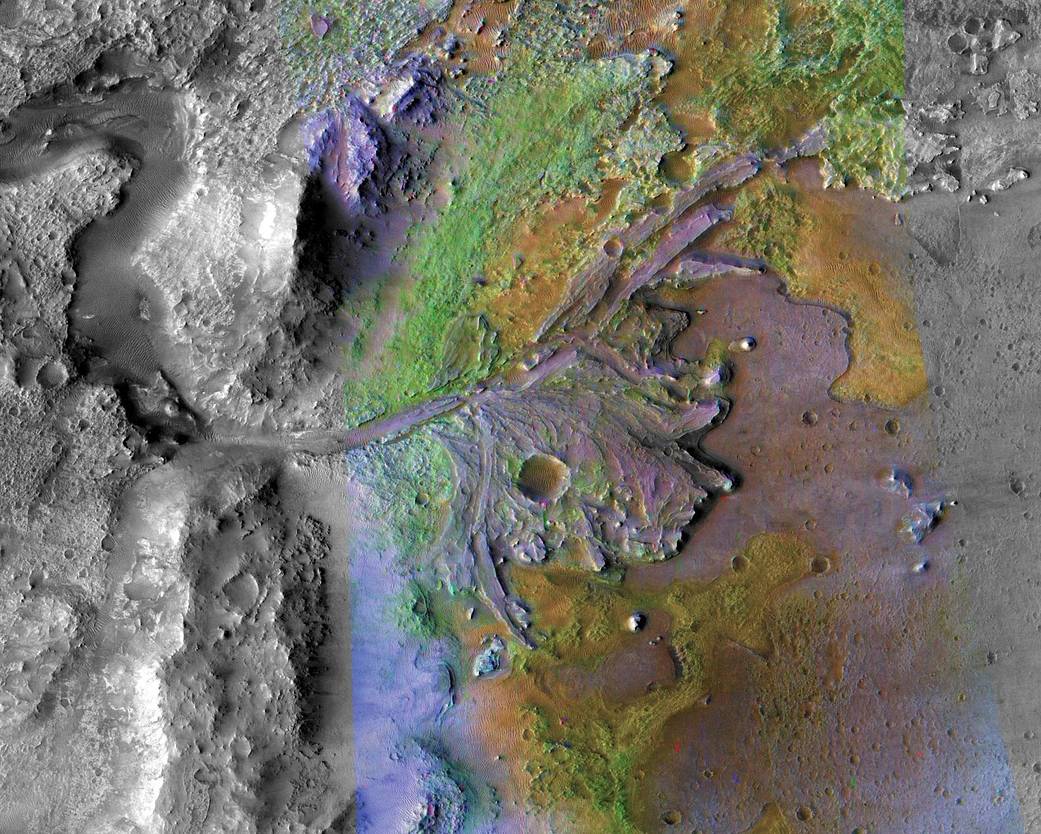Rock Samples From The Floor of Jezero Crater Show Significant Contact With Water Together With Possible Organic Compounds

Analysis of multiple rocks found at the bottom of Jezero Crater on Mars, where the Perseverance rover landed in 2020, reveals significant interaction between the rocks and liquid water, according to a study publishing on November 24 in Science. Those rocks also contain evidence consistent with the presence of organic compounds.
The existence of organic compounds (chemical compounds with carbon–hydrogen bonds) is not direct evidence of life, as these compounds can be created through nonbiological processes.
Perseverance previously found organic compounds at Jezero’s delta. Deltas are fan-shaped geologic formations created at the intersection of a river and a lake at the edge of the crater. Mars 2020 mission scientists had been particularly interested in the Jezero delta because such formations are created when a river transporting fine-grained sediments enter a deeper, slower-moving body of water. As the river water spreads out, it abruptly slows down, depositing the sediments it is carrying—and in so doing, traps and preserves any microorganisms that may exist in the water.
However, the crater floor, where the rover landed for safety reasons before traveling to the delta, was more of a mystery. In lake beds, one expects to find sedimentary rocks, because the water deposits layer after layer of sediment. However, when the rover touched down there and had a look around, some researchers were surprised to note igneous rocks (which is cooled magma) on the crater floor with minerals in them that recorded not just igneous processes but significant contact with water.
“The nature of the water interaction with the igneous rocks is very intriguing and unique chemically. There are carbonates, which require CO2 dissolved in water to form. There are also fascinating combinations of materials such as sulfate and perchlorate, likely formed through evaporating water,” says Eva Scheller (PhD ’22), now a postdoctoral fellow at MIT. Scheller, the corresponding author of the Science paper, conducted this research on the Jezero Crater floor during her doctoral work at Caltech.
The signs of different types of salts, including carbonates, sulfates, and perchlorates along with co-located possible organic compounds were discovered using SHERLOC, or the Scanning Habitable Environments with Raman & Luminescence for Organics & Chemicals instrument. Mounted on the rover’s robotic arm, SHERLOC is equipped with a number of tools, including a Raman spectrometer that utilizes a specific type of fluorescence to search for organic compounds and also see how they are distributed in a material, providing insight into how they were preserved in that location.

Sample collection by Perseverance on Mars. This image mosaic was acquired by the WATSON camera on the rover’s robot arm. Rock cores were drilled from the two holes (arrow) in an igneous rock of the Máaz formation. The 6-cm-long, 1.3-cm-diameter cores were sealed into individual sample tubes and are now stored inside the rover.
“The microscopic compositional imaging capabilities of SHERLOC have really blown open our ability to decipher the time-ordering of Mars’s past environments,” says Bethany Ehlmann, co-author of the Sciencepaper, professor of planetary science, and associate director of the Keck Institute for Space Studies. “The microscopic fingerprints show igneous rocks formed and then water circulated through them, altering the rocks and depositing minerals in voids and cracks. In some places, data show evidence for organics within these potentially habitable niches.”
As the rover rolled toward the delta, it took several samples of the water-altered igneous rocks and cached them for a possible future sample-return mission. Determining definitively the nature of past wet environments, the presence and type of organics – and whether these have anything to do with life – requires returning the samples to Earth for examination in laboratories with advanced instrumentation.
“These will be key samples for understanding environments on ancient Mars and whether they had conditions suitable for life or even hosted life,” Scheller says.
The Science paper has numerous co-authors from multiple institutions worldwide. This research was funded by NASA, the European Research Council, the Swedish National Space Agency, and the UK Space Agency.
Aqueously altered igneous rocks sampled on the floor of Jezero crater, Mars, Science
Astrobiology








